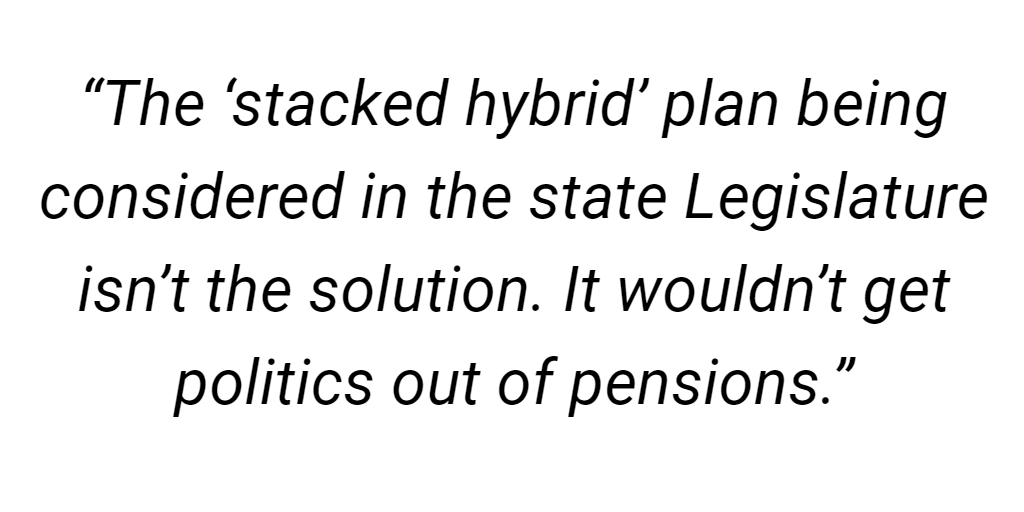Note: This commentary appeared in the Bucks County Courier Times, Delaware County Daily Times, and other outlets.
Ten years ago, I was one of several voices warning of the public pension iceberg that could sink our state’s financial stability, threaten government employees’ retirements, and leave hardworking Pennsylvanians drowning in billions of dollars of debt.
At the time, however, many were dismissive of such risks and effectively chose to wish the problem away.
In 2006, David Fillman, president of AFSCME Council 13, the largest state workers’ union, declared, “Pennsylvania is not the Titanic, and there are no icebergs in our pension fund’s future.” The Pennsylvania State Education Associate (PSEA) similarly claimed in 2007, “There is no crisis in the Pennsylvania state pension plans.”
Today, those words—and the failure to enact comprehensive reforms in the years since—are hard to swallow. Of note, both unions have removed the statements from their websites. Pension debt, however, isn’t as easy to erase.
 Unfortunately, hope is a not a strategy. Closing your eyes to an iceberg doesn’t make it disappear.
Unfortunately, hope is a not a strategy. Closing your eyes to an iceberg doesn’t make it disappear.
Since 2006, our combined state pension unfunded liability—today’s gap between what plan participants have been promised and what is actually in the respective pension trust funds—has skyrocketed from $7.6 billion to more than $63 billion. Sadly, this astounding 730 percent increase in debt for the Public School Employees’ Retirement System (PSERS) and the State Employees’ Retirement System (SERS) will likely be transferred to the next generation.
In ten years, the funding ratio (plan assets versus accrued liabilities) for PSERS and SERS has plummeted from 92 percent to just 55 percent. The combined market value of our pension funds actually fell by almost 10 percent during that time.
Ironically, at the same time these plans generally underperformed investment expectations, while underfunding continued. This reinforces the adage that “properly funding public pension plans has a low political rate-of-return.”
Pennsylvanians are bearing the consequences of this short-term thinking. Due to rising pension costs, school districts have cut back on popular programs and sought new revenue sources. As a result, property taxes have climbed across the state, jeopardizing the livelihoods of Pennsylvanians on fixed incomes.
Yet, instead of controlling skyrocketing pension costs, state policymakers have continued the practice of underfunding while modifying (defined) benefits for new hires. These incremental reforms have failed to address the ever-growing unfunded liability.
It’s no coincidence that rating agencies Moody’s, Standard & Poor’s, and Fitch have repeatedly downgraded Pennsylvania’s credit ratings over the past several years, regularly citing growing pension unfunded liabilities as a major reason.
While plan participants have paid their required contributions, taxpayers have also paid their required taxes. Therefore, the problem is a political one, inherent in the nature of public-sector defined benefit pension plans.
As Pennsylvania continues approaching the public pension iceberg at full speed, how can we avoid a collision? Simply put, through reforms that mirror steps taken by the private sector years ago.
First, we must move all new state hires to a defined contribution plan modeled after the 401(k). Such plans cannot be underfunded and so eliminate the possibility of political manipulation that leads to billions in debt. Defined contribution plans are also owned by participants and are portable from one job to another.
Concurrently, lawmakers must also significantly increase near-term pension system contributions to address long-term solvency risks. For too long, we’ve avoided properly funding our pension systems.
 Unfortunately, the “stacked hybrid” plan being considered in the state Legislature isn’t the solution. It wouldn’t get politics out of pensions. The problematic defined benefit plan would still remain, with many employee groups exempted. In addition, taxpayers would remain at risk for increased debt. It is quite telling that this type of plan design is not found in the private sector.
Unfortunately, the “stacked hybrid” plan being considered in the state Legislature isn’t the solution. It wouldn’t get politics out of pensions. The problematic defined benefit plan would still remain, with many employee groups exempted. In addition, taxpayers would remain at risk for increased debt. It is quite telling that this type of plan design is not found in the private sector.
Nor is simply raising taxes a viable option. Pennsylvania is already the 15th highest-taxed state in terms of per-capita share of state income, with a net out-migration of its citizenry. Making the tax burden heavier will drive people and job creators away even more quickly.
We must realize that the old pension system is broken. New hires and taxpayers alike deserve something more reliable, predictable, and affordable, like the 401(k).
Ten years ago, too many ignored the warnings of looming pension danger. We cannot afford another decade of inaction as we accelerate on a collision course with the pension iceberg.
# # #
Richard C. Dreyfuss is a senior fellow with the Commonwealth Foundation (CommonwealthFoundation.org), Pennsylvania's free-market think tank.
RELATED : TAXES & SPENDING, PENSION REFORM, UNIONS & LABOR POLICY

